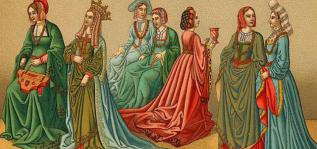The Dark Ages
The dark
ages also known as the middle ages were the time of the decline of the Roman
Empire. It was the time of cultural and economic deterioration. This period
between 500- 1500 AD were dark times. It was the times of the religious superstitions
and of the Black Death the bubonic plague, causing devastation in Europe.
During this
period people in different parts of Europe wore different clothing’s also
varying the clothing according to the social class a person belonged to. These
differences were shown in the clothing styles as well as the material of the
clothes.
The
pheasants, slaves and the low classes could not afford the high quality
materials due to the sumptuary laws. The basic garment that they wore were
tunics made of cloth or leather and an over tunic in the colder weather.
The clothing for the lower class was usually
made of woven wool. Men and women both wore similar clothing, the tunics, with
slight differences. The tunics were made of long rectangular wool
with a hole in the center for the head and crude stitching at the sides,
leaving a gap for the neck. Sleeves were not a part of the original garment and
were optional to be added in the future.
Men and
women used to wear tunics with slight differences. They used to modify their
tunics by cutting slits for places such as arms, legs and the sides for more
free movement. The idle tunic length was till thighs, but men would often let
the tunics fall just past their knees, while the women would let the tunics
fall down their legs to give them the look of a dress.
The length
of a men’s tunic depended on their occupation. The workers wore shorter tunics
than those who performed more refined tasks.
The men’s
tunic was often made of coarser wool and was not as brightly colored as women’s
clothing. Men’s tunics were made of undyed wool and were of the colors beige,
brown or gray.
Though
the garment might be called by different names at different places and during
different periods of time, essentially the basic construction of the tunic was
the same throughout the centuries.
The clothing of the wealthy was made of finer
fabrics. The under tunics were made of linen were much lighter in weight than
those made of wool, and were more durable and comfortable. The production of
linen was more time consuming and expensive to purchase and was not affordable
by the common serfs.

The clothes for Nobles and the aristocracy
were made by professional weavers and tailors. Their clothes were made from the
most lavish and expensive materials like silk and velvet. Heavier cloth called
‘damask’ was also worn with fur trimmings for the sleeves and the outfit. The
nobles also wore fine jewels and diamonds. Their clothing were brightly colored
and embellished with jewels.
The women wore full length tunics. The richer
the women the more luxurious her clothing was. The women tunics transformed
into flowing gowns with elaborate Headgears and veils.






No comments:
Post a Comment